- Skip Storing This Everyday Product in the Fridge Door
- Green Tea + B3 Pairing May Boost Brain Health
- Navigating Your Midlife Crisis: Embracing New Possibilities
- City Raccoons Showing Signs of Domestication
- Mapping the Exposome: Science Broadens Focus to Environmental Disease Triggers
- One Week Less on Social Media Linked to Better Mental Health
- Your Brain Changes in Stages as You Age, Study Finds
- Some Suicide Victims Show No Typical Warning Signs, Study Finds
- ByHeart Formula Faces Lawsuits After Babies Sickened With Botulism
- Switch to Vegan Diet Could Cut Your Greenhouse Gas Emissions in Half
Most Americans Were Staying Home Before Government Mandates: Study

Most Americans voluntarily stayed at home during the early days of the COVID-19 tsunami, before states began issuing official “shelter-in-place” orders, new research indicates.
Why? Because statewide emergency declarations coupled with news — of first infections, first fatalities and school closures — were motivation enough to get folks to stay home. This was more motivating than quarantine mandates imposed weeks later, say investigators.
The findings follow a review of U.S. cellphone signal patterns from early March through much of April. The data generated by more than 20 million smartphones a day across all 50 states illustrated how much or how little users were moving about on a daily basis. That information was then stacked up against a timeline of state and local policy decisions.
Since March, “mobility fell substantially in all states. Even ones that have not adopted major distancing mandates,” said study lead author Sumedha Gupta, an assistant professor of economics at Indiana University-Purdue University Indianapolis.
That, she said, is because, even without stay-at-home requirements, people responded almost immediately to the alarming information they were getting.
“There is little evidence that stay-at-home mandates induced distancing,” said Gupta. Instead, it appears that “early and information-focused actions have had bigger effects.”
The findings, which have not been peer-reviewed, should be considered preliminary. They appear in a “working paper” published recently by the nonprofit National Bureau of Economic Research.
The team compiled a list of policy “events” as they unfolded. In most states that trajectory began with a series of emergency declarations, including a State of Emergency, a Public Health Emergency, and/or a Public Health Disaster.
By March 16, all 50 states had enacted these measures, although they did not specifically impose restrictions on movement. But they often overlapped with news reports of the first local cases and deaths, and likely “conveyed the seriousness of the situation to the population,” the researchers said.
School closures were typically put in place a bit later, although 48 states had made the move by April 7.
By contrast, state and county stay-at-home orders were usually the last to be issued, although they were the measures that most directly addressed mobility. By mid-April, 45 states (or communities within states) had taken this step, with the exception of Arkansas, Iowa, Nebraska, North Dakota and South Dakota.
These developments were then aligned with publicly available cellphone data obtained from sources such as Apple Mobility, Google Mobility, SafeGraph, and PlaceIQ. The information was used to track movement outside the home during the 20 days before and after each policy was enacted.
The conclusion: Mobility fell hard and fell early, before the passage of mitigation policies. And that meant that by the time shelter-in-place orders had been declared they had almost no appreciable impact, the team said.
Specifically, Gupta’s team determined that roughly 55% of the decisions people made to stay at home were attributable to emergency declarations issued in March. The rest were likely a function of individuals choosing to limit their movement based on news and information they received, rather than edicts.
Still, Gupta cautioned that as quarantine fatigue grows, the influence of news could wane.
“Over time, individuals may be less inclined to continue to restrict their mobility and interactions,” Gupta said. So it’s possible that as the pandemic continues to unfold, government leadership coupled with safety mandates and enforcement may become more critical, not less.
That thought was echoed by retired Brigadier Gen. Thomas Kolditz, founding director of Rice University’s Doerr Institute for New Leaders in Houston.
“For most of the past 20 years, polls by Gallup and others show that people trust local government more than state government,” he noted, “and local conditions tend to dictate localized behaviors. People make judgments about what’s happening around them.”
The problem, however, is that people can “vary widely in terms of personal discipline and resilience,” Kolditz observed. And as steps are taken toward an economic restart, “reopening guidance has been so complex that the likelihood of a disciplined reopening is very low,” he added.
All of this means that statewide guidance, in coordination with local leadership, will have a key role to play, Kolditz believes. “Without coordinated state guidance, states are likely to experience increasingly negative aspects of both staying at home and reopening,” he said.
More information
There’s more about sheltering in place at the U.S. Centers for Disease Control and Prevention.
Source: HealthDay
Copyright © 2025 HealthDay. All rights reserved.










